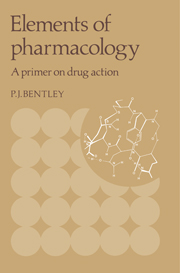Book contents
- Frontmatter
- Contents
- Preface
- 1 Introduction
- 2 Scope of pharmacology
- 3 Where do drugs come from?
- 4 The names of drugs
- 5 Techniques and methods of pharmacology
- 6 Absorption, distribution, and elimination of drugs; pharmacokinetics
- 7 The nature of responses to drugs
- 8 Receptor theory
- 9 Relationship of chemical structure to biological activity
- 10 Roles of the cell membrane in responses to drugs
- 11 Clinical aspects of the actions of drugs
- 12 Conclusion
- References
- Glossary of drugs named in the text
- Index
11 - Clinical aspects of the actions of drugs
Published online by Cambridge University Press: 29 January 2010
- Frontmatter
- Contents
- Preface
- 1 Introduction
- 2 Scope of pharmacology
- 3 Where do drugs come from?
- 4 The names of drugs
- 5 Techniques and methods of pharmacology
- 6 Absorption, distribution, and elimination of drugs; pharmacokinetics
- 7 The nature of responses to drugs
- 8 Receptor theory
- 9 Relationship of chemical structure to biological activity
- 10 Roles of the cell membrane in responses to drugs
- 11 Clinical aspects of the actions of drugs
- 12 Conclusion
- References
- Glossary of drugs named in the text
- Index
Summary
In its clinical use a drug is intended to have a therapeutic action, but it can also promote toxic reactions and have side effects. The latter can reflect deficiencies in a drug's selectivity and may even occur at the same time or with smaller doses than those that are therapeutically effective. Side effects can also result from excessive doses of drugs, which are then said to be at toxic concentrations and ultimately may even result in death. Such toxic effects are often merely extensions of therapeutic effects. Drug concentrations in the blood provide a convenient way of predicting drug effects. Concentrations can be divided into four general levels: the concentration of the drug that is the threshold of the therapeutic response, the maximal concentration for a therapeutic effect, the concentration where toxic effects may be expected to occur, and the lethal concentration.
The difference between the maximally effective therapeutic dose and that at which toxic effects may be expected to occur can be large or relatively small, and depends mainly on the drug. The greater the difference between these two concentrations, the safer the drug is expected to be. This safety factor may be expressed in terms of the therapeutic index, which is the ratio of the dose that has a lethal effect (LD) to the dose that is therapeutically effective (ED). Thus, the larger the therapeutic index, the safer the drug. The therapeutic index has various meanings; based on animal experiments, it can be calculated as the ratio of the lethal and effective doses expressed as a percentage of the population that responds.
- Type
- Chapter
- Information
- Elements of PharmacologyA Primer on Drug Action, pp. 89 - 137Publisher: Cambridge University PressPrint publication year: 1981



